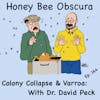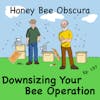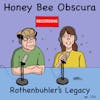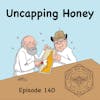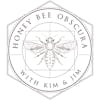Rothenbuhler's Legacy (152)

In today’s episode Jim invites Becky Masterman to discuss the lasting impact of Dr. Walter Rothenbuhler’s seminal research on honey bee hygienic behavior. His work, which has been a bedrock in the field of apiculture, sheds light on the genetic...
In today’s episode Jim invites Becky Masterman to discuss the lasting impact of Dr. Walter Rothenbuhler’s seminal research on honey bee hygienic behavior. His work, which has been a bedrock in the field of apiculture, sheds light on the genetic foundations of disease resistance among honey bees, particularly against threats like American Foulbrood.
Jim provides a unique inside perspective to Dr. Rothenbuhler as Jim personally knew and worked with him at The Ohio State University bee lab.
Today's discussion centers around the critical behavior of bees known as ‘hygienic behavior,' where bees detect and eliminate diseased or parasitized brood from the hive, thereby protecting the colony from outbreaks. This behavior, identified and explored by Dr. Rothenbuhler, is a key trait that bee breeders prioritize to foster robust colonies.
Jim and Becky navigate the connections between Dr. Rothenbuhler’s, and that of other early researchers’ findings and their practical applications in contemporary beekeeping. The insights from their research are essential for selective breeding programs that aim to enhance colony health and disease resistance.
Concluding the episode, Jim and Becky reflect on the enduring relevance of Dr. Rothenbuhler’s contributions to apiculture. His legacy not only informs our current practices but also continues to guide research and advancements in the field of beekeeping.
Tune in for this fascinating journey through bee behavior research and its profound implications for beekeepers around the world.
______________________

Thanks to Betterbee for sponsoring today's episode. Betterbee’s mission is to support every beekeeper with excellent customer service, continued education and quality equipment. From their colorful and informative catalog to their support of beekeeper educational activities, including this podcast series, Betterbee truly is Beekeepers Serving Beekeepers. See for yourself at www.betterbee.com
______________________
Honey Bee Obscura is brought to you by Growing Planet Media, LLC, the home of Beekeeping Today Podcast.
Music: Heart & Soul by Gyom, All We Know by Midway Music, original guitar music by Jeffrey Ott
Cartoons by: John Martin (Beezwax Comics)
Copyright © 2023 by Growing Planet Media, LLC

Episode 152 – Rothenbuhler's Legacy
Jim Tew: Beekeepers, hi. It's that time of the week again where we talk about something beekeeping. Give me just a minute to get you set up for it, but what's on my mind this week and on the mind of Becky Masterman who's visiting with us today, and I hope comes by more often but more about that later. Do you realize, beekeepers, how often we stand on the concept of hygienic behavior in bees and what it means to us, and how many of the queens that we buy and pay all this money for that we complain about?
How important that is to us? It had a history, and I'd like to spend some time just reviewing parts and pieces of that history as I remember it. Those of you who remember it differently then that's just your opinion, because this is what I remember. Can we talk for a few minutes? Hi, Becky. Can we talk for a few minutes?
Becky Masterman: Hi, Jim. Absolutely, I think we can both talk just about what we remember and then we're going to put together a great 20 minutes.
Jim: I hope it's great. I'll just take 20 minutes of any kind. [laughter] Hi, I'm Jim Tew.
Becky: I'm Becky Masterman from Beekeeping Today Podcast.
Jim: We're coming to you from Honey Bee Obscura where once a week we talk about anything beekeeping. Today, give us a chance, beekeepers, give us a chance. We want to talk about the foundation principles of hygienic behavior.
Introduction: You are listening to Honey Bee Obscura, brought to you by Growing Planet Media, the folks behind Beekeeping Today Podcast. Each week on Honey Bee Obscura, hosts Kim Flottum and Jim Tew explore the complexities, the beauty, the fun, and the challenges of managing honeybees in today's world. Get ready for an engaging discussion to delight and inform all beekeepers. If you're a long-timer or just starting out, sit back and enjoy the next several minutes as Kim and Jim explore all things honeybees.
Jim: Becky, I had the good experience accidentally of actually knowing doctor Walter Rothenbuhler, who did a lot of this work and really laid the foundation for this old thing of hygienic behavior. As almost a child sitting in his lecture, sitting around tables, we were both in the same department here at Ohio State. There's Dr. Rothenbuhler talking about it, on the other end of the table is Dr. Borror and Dr. DeLong, who wrote the entomology book that I used in Alabama. These people just sat around like mere mortals, but they were actually gods in the entomology world.
Becky: It's just amazing how people that you cite in your papers, Rothenbuhler is cited in my PhD dissertation. It's amazing how these people that you just know their names and you've read their papers, but they were actual part of departments and they were colleagues. That's a whole 'nother story that I'm hoping you share a little bit with me as far as Dr. Rothenbuhler.
Jim: Well, I'll do my best, but you see these are 40, 45-year-old memories. When you get to be as old as I am, if you can't really remember, just make it up because there's no one really around to argue with you. This is as I remember. First of all and foremost, and I think Dr. Rothenbuhler, if I dare speak on his behalf, would want this known. He was a very kind serious man with awry appropriate sense of humor, and he had the extraordinary ability to make time for anyone.
I had students who came from Burma, and I casually ask him if he would teach them in instrumental insemination as though the man had nothing else to do. He took five or six Burmese beekeeping students and spent a day with them, teaching them this procedure that they were never going to use. Everybody around the world thought they wanted this because it was so sophisticated. He was just that kind of a man. It's important that you know that he was very self-effacing, very quiet, humble, and extremely competent.
Becky: He was the father of the hygienic behavior movement. He inspired so many different scientist down the road, who have really used this tool to support honeybee health. I think that the fact that he was operating a lab where he was welcoming people from all over and sharing his skills, the skills that he used in order to study hygienic behavior. I think that's really nice to know, and it brings to life a little bit my memory of using his work and his information in the work that I did. Jim, I think we have to take a quick minute to talk about hygienic behavior and what it is.
Because I know that there are beekeepers out there thinking, "This is the behavior where my bees are super clean, and they put everything away before going to bed at night," but that's not it. Hygienic behavior is this unique genetic trait where the bees are able to detect, uncap, and remove diseased or parasitized pupae from the nest before becomes infectious in the case of American foulbrood. In the case of Varroa, the Varroa mite reproductive cycle is disrupted if the bees are performing hygienic behavior. It's a really specific genetic trait that you find in not many colonies, and that's why so many beekeepers have taken upon themselves to breed and select for it.
Jim: It's a very desirable trait, and you really want bees to clean house and to do this nicely. The one thing I have no memory of and have no way to address how Dr. Rothenbuhler came up with that descriptive term, hygienic behavior. I don't know what other options he looked at before he chose that, but it's become standard text now that had its Genesis with him.
Becky: I think, Jim, he thought hygienic may sound better than cannibalistic murdering behavior, because what they're actually doing is taking their-
Jim: Garbage-consuming or whatever.
Becky: Oh, yes. Removing their own siblings from the nest and killing them in that behavior. I think he used a really nice term instead of something that might be a little bit harder for beekeepers to embrace.
Jim: I like that concept. He had those two lines, and this is where I'm going to go out on a lam and just tell people what I remember. I don't think I could make up this much detail from this old memory, but he had the two lines, the Van Scoy line that was his acceptable line, and the Brown line of bees that was his resistant line. This is the story, I remember, even though Marla's paper admirably done , she said that Brown was a beekeeper who let bees rob out his wax before he rendered the wax.
How could I make this up? I thought that Brown was a bee inspector, and that any colony that was deemed to have American foulbrood-- and this is important that we know this point. That American foulbrood was the premier disease of the day, so that was what your worried about. If an inspector said you had American foulbrood, kaboom, you've got it. I don't think Brown was doing anything illegal or untoward, but instead of just burning the colony right there he had in my mind this elephant graveyard situation, where he would take these colonies there, probably to be robbed out or whatever.
Dr. Rothenbuhler said in the middle of all this death and destruction, would be was a small number of colonies that were almost thriving. He was able to take, I think, four of those hives and develop that into this line called the Brown line, which sounds like a color, but no, it was the man's name. That became the basis for his resistant line when he backcrossed in that population.
Becky: Now I want to start looking at the library online and seeing if we can find that story in one of the--
Jim: I wish you wouldn't. I really wish you wouldn't look, because if you found out I'm dead wrong-
Becky: Okay, we're just going to take it.
Jim: -then what would I do, would I come back and cut another section?
Becky: I wouldn't tell anybody, but it's just that is an amazing story you just told.
Jim: I hope it's true, but give me just a minute while we hear from our sponsor for me to be sure that it was a real memory.
[music]
Betterbee: Are you ready to savor the sweet rewards of beekeeping? Look no further. Betterbee is proud to offer honey extraction and processing equipment, brought to you by the renowned Lyson. Lyson is a global leader known for their impeccable craftsmanship and cutting-edge designs. Unlike other options, Lyson extractors boast unrivaled durability and are certified food grade, making them safe for health and the environment. Plus the rust-resistant stainless steel is a breeze to clean, promising an extended service life. From 4-frame to 56-frame extractors, we've got you covered. Visit betterbee.com/extract to explore our wide range of options.
Jim: Becky, I must tell you that I'm really uncertain about the Van Scoy line as much. That was a line of the susceptible bees that he picked up in New York. I don't know how he found that and how he got all the way from Iowa to New York. I don't know much about that line.
Becky: That's so interesting. I know that when I was at the University of Minnesota, Marla got our two lines by selecting for them in the yards. So it's so interesting that Dr. Rothenbuhler found his lines based upon one, based upon resistance to AFB. Then two, moved it all the way from another state and didn't decide to find that trait that he couldn't find it or didn't look for it or for some reason wasn't successful. That's a really interesting fact that it came from outside of the state.
Jim: He didn't have 50 colonies. The work was done with just a few colonies, probably less than 10 to 15 colonies that they maintained that just meant the world to them. I've had two storms come through my bee yard that destroyed beehives, and I'm thinking, "Well, what did they do to protect these things? They had entire investigative careers established on this, and they meant so much to them." Dr. Rothenbuhler did a lot of AI work. I'm honored to say he taught me to do it. It's a skill that I haven't used in many decades now and probably never will again.
He used a homemade device, and in the earliest days that were mechanical pencils that you twisted the eraser and it would drive the lead out of the pencil, a scripto pencil, and some of the earliest syringes were made were modifications of those mechanical pencils. These were really primitive devices. Dr. Rothenbuhler's device was probably half homemade. It actually had small pieces of wood in it that he did all this sophisticated instrumental insemination work at the time.
Becky: It's such a delicate procedure and the queens have to be protected from infection, and just the slightest of movement as you know can really call the whole thing off. Artificial insemination it's a skill that we luckily have some very gifted people who are able to inseminate queens now, which is, I think, important also. In the bigger picture, it's something that people in livestock do all the time. I'm wondering Dr. Rothenbuhler, was he at the forefront again? Was he one of the first in the United States to be using AI?
Jim: He was one of the first but he was not the first in developing it. Others, Otto Mackensen, OW Park, people who I've just only seen papers and handwritten notes to Dr. Rothenbuhler. Those guys were in the vanguard working out the technique and the procedure for that. You know what mindless patience they must have had. If you depended on Jim Tew to lay the foundation for instrumental insemination procedures, it ain't going to happen because I'm not going to sit here and try to take grinding rocks and fine-tune these probes and narco-size queens and figure out you need narco-size them one-- no, ain't going to happen.
These guys had patience that have to be admired from afar and out. We don't know their names. Most of the beekeepers who have listened this far to this podcast have no idea who we're talking about. These men are long gone, but they spent their entire lives getting us to this point, and we quietly now stand on their shoulders while we develop our breeding programs for the resistance to Varroa and these viral infections that we've got going. Dr. Rothenbuhler, even himself, could not have foreseen how valuable his concept of hygienic behavior would've been.
Becky: I think that's a great way to say that. He did have a lab, was that lab at the Ohio State University built for him or just named after him?
Jim: How much time do we have?
Becky: My goodness...
Jim: Dr. Rothenbuhler did his work from a converted university chicken breeding program. It was embarrassing. He kept saying that he was like Moses, that he could always be allowed to look over into the promised land of a new lab, but he was never going to be allowed to cross over. That was the case. Dr. Rothenbuhler was already in very poor health when the Rothenbuhler lab was finally built and dedicated, but he was long retired and long gone.
He was the consummate gentleman and he sat there with the university president and accepted the award of that building finally being put up on his behalf, but he never worked there. He did his premier work from a reclaimed chicken research facility that's now been plowed under, and it's pretty much where second base is on the Ohio State University baseball field.
Becky: Oh my goodness.
Jim: So just goes on and on. The other thing-- I got to stop this, but I don't know what happened, but Iowa State had the bee program. If you look at the early work, it's all Iowa State, and in some way Ohio State either bought or hired or did whatever and moved Walter Rothenbuhler and Vic Thompson from Ames to Columbus, and they brought a semi-load of equipment. When I first came in 1978 to Ohio State, you could still see occasional pieces of equipment that was branded with Iowa State's name, ISU on it.
I don't know why Iowa decided to get out of the bee business, and I don't know why Ohio State decided to get into the bee business, but Dr. Hachiro Shimanuki to my knowledge, was one of the last students of Dr. Rothenbuhler while he was still at Iowa. Now I'm probably offending someone here who actually lived that, but that was my understanding that he was one of the last students from there.
What did all of this mean? This man was real. This was a man who went to church and who had kids and who had a loving wife named Claire, who worked with him constantly. It was Vic Thompson, his lifelong lab associate who did the lab work and kept up and numbered frames, and did the absolute statistical insanity that lets this science come to pass. These were all real people who did this work that beekeepers today profit so much from.
Becky: I appreciate that perspective. I think beekeepers are used to seeing scientists present their information, and they're used to seeing us put those references on the slides. Now I'm hoping that the listeners, next time they go to a presentation and next time they see a scientist show references as far as citing people's work. They realize that those are people who honestly have devoted a lot of their life and their families have devoted their time to supporting really honeybee health and planting the seeds for some amazing, amazing tools that our beekeepers are using today.
Jim: Thank you. That was very elegantly said. I can't add anything to it. Raw, raw hygienic behavior is a fact of life for us now, but it wasn't always that way. Becky, thank you for coming by today. I hope we can chat again sometime. I enjoyed it very much. Thank you for letting me walk down memory lane.
Becky: Thank you so much, Jim, I appreciate it.
Jim: Goodbye to all the listeners.
[END OF AUDIO]
New to Honey Bee Obscura Podcast?
Here are some great episodes to start with. Or, check out episodes by topic.







 In today’s episode Jim invites Becky Masterman to discuss the lasting impact of Dr. Walter Rothenbuhler’s seminal research on honey bee hygienic behavior. His work, which has been a bedrock in the field of apiculture, sheds light on the genetic foundations of disease resistance among honey bees, particularly against threats like American Foulbrood.
In today’s episode Jim invites Becky Masterman to discuss the lasting impact of Dr. Walter Rothenbuhler’s seminal research on honey bee hygienic behavior. His work, which has been a bedrock in the field of apiculture, sheds light on the genetic foundations of disease resistance among honey bees, particularly against threats like American Foulbrood.

